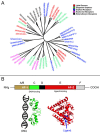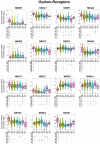Lipid-sensors, enigmatic-orphan and orphan nuclear receptors as therapeutic targets in breast-cancer
- PMID: 26894976
- PMCID: PMC5173165
- DOI: 10.18632/oncotarget.7410
Lipid-sensors, enigmatic-orphan and orphan nuclear receptors as therapeutic targets in breast-cancer
Abstract
Breast-cancer is heterogeneous and consists of various groups with different biological characteristics. Innovative pharmacological approaches accounting for this heterogeneity are needed. The forty eight human Nuclear-Hormone-Receptors are ligand-dependent transcription-factors and are classified into Endocrine-Receptors, Adopted-Orphan-Receptors (Lipid-sensors and Enigmatic-Orphans) and Orphan-receptors. Nuclear-Receptors represent ideal targets for the design/synthesis of pharmacological ligands. We provide an overview of the literature available on the expression and potential role played by Lipid-sensors, Enigmatic-Orphans and Orphan-Receptors in breast-cancer. The data are complemented by an analysis of the expression levels of each selected Nuclear-Receptor in the PAM50 breast-cancer groups, following re-elaboration of the data publicly available. The major aim is to support the idea that some of the Nuclear-Receptors represent largely unexploited therapeutic-targets in breast-cancer treatment/chemo-prevention. On the basis of our analysis, we conclude that the Lipid-Sensors, NR1C3, NR1H2 and NR1H3 are likely to be onco-suppressors in breast-cancer. The Enigmatic-Orphans, NR1F1 NR2A1 and NR3B3 as well as the Orphan-Receptors, NR0B1, NR0B2, NR1D1, NR2F1, NR2F2 and NR4A3 exert a similar action. These Nuclear-Receptors represent candidates for the development of therapeutic strategies aimed at increasing their expression or activating them in tumor cells. The group of Nuclear-Receptors endowed with potential oncogenic properties consists of the Lipid-Sensors, NR1C2 and NR1I2, the Enigmatic-Orphans, NR1F3, NR3B1 and NR5A2, as well as the Orphan-Receptors, NR2E1, NR2E3 and NR6A1. These oncogenic Nuclear-Receptors should be targeted with selective antagonists, reverse-agonists or agents/strategies capable of reducing their expression in breast-cancer cells.
Keywords: breast cancer; chemo-prevention; drug targets; nuclear receptors; treatment.
Conflict of interest statement
There is no conflict of interest.
Figures





Similar articles
-
Minireview: role of orphan nuclear receptors in cancer and potential as drug targets.Mol Endocrinol. 2014 Feb;28(2):157-72. doi: 10.1210/me.2013-1291. Epub 2013 Dec 2. Mol Endocrinol. 2014. PMID: 24295738 Free PMC article. Review.
-
Orphan nuclear receptors as drug targets for the treatment of prostate and breast cancers.Cancer Treat Rev. 2014 Dec;40(10):1137-52. doi: 10.1016/j.ctrv.2014.10.005. Cancer Treat Rev. 2014. PMID: 25455729 Review.
-
Functional crosstalk of CAR-LXR and ROR-LXR in drug metabolism and lipid metabolism.Adv Drug Deliv Rev. 2010 Oct 30;62(13):1316-21. doi: 10.1016/j.addr.2010.07.006. Epub 2010 Jul 24. Adv Drug Deliv Rev. 2010. PMID: 20659512 Review.
-
Gene silencing by nuclear orphan receptors.Vitam Horm. 2004;68:1-48. doi: 10.1016/S0083-6729(04)68001-0. Vitam Horm. 2004. PMID: 15193450 Review.
-
Orphan nuclear receptors in drug discovery.Drug Discov Today. 2007 Jun;12(11-12):440-5. doi: 10.1016/j.drudis.2007.04.006. Epub 2007 Apr 26. Drug Discov Today. 2007. PMID: 17532527 Free PMC article. Review.
Cited by
-
Antimitotic activity of DY131 and the estrogen-related receptor beta 2 (ERRβ2) splice variant in breast cancer.Oncotarget. 2016 Jul 26;7(30):47201-47220. doi: 10.18632/oncotarget.9719. Oncotarget. 2016. PMID: 27363015 Free PMC article.
-
Revisiting the Syndecans: Master Signaling Regulators with Prognostic and Targetable Therapeutic Values in Breast Carcinoma.Cancers (Basel). 2023 Mar 16;15(6):1794. doi: 10.3390/cancers15061794. Cancers (Basel). 2023. PMID: 36980680 Free PMC article. Review.
-
NR1H3 Expression is a Prognostic Factor of Overall Survival for Patients with Muscle-Invasive Bladder Cancer.J Cancer. 2017 Mar 7;8(5):852-860. doi: 10.7150/jca.17845. eCollection 2017. J Cancer. 2017. PMID: 28382148 Free PMC article.
-
Human nuclear receptors (NRs) genes have prognostic significance in hepatocellular carcinoma patients.World J Surg Oncol. 2021 Apr 30;19(1):137. doi: 10.1186/s12957-021-02246-x. World J Surg Oncol. 2021. PMID: 33941198 Free PMC article.
-
The orphan nuclear receptor estrogen-related receptor beta (ERRβ) in triple-negative breast cancer.Breast Cancer Res Treat. 2020 Feb;179(3):585-604. doi: 10.1007/s10549-019-05485-5. Epub 2019 Nov 19. Breast Cancer Res Treat. 2020. PMID: 31741180 Free PMC article.
References
-
- Welsh J. Vitamin D and prevention of breast cancer. Acta Pharmacol Sin. 2007;28(9):1373–1382. - PubMed
-
- Centritto F, Paroni G, Bolis M, Garattini SK, Kurosaki M, Barzago MM, Zanetti A, Fisher JN, Scott MF, Pattini L, Lupi M, Ubezio P, Piccotti F, Zambelli A, Rizzo P, Gianni M, et al. Cellular and molecular determinants of all-trans retinoic acid sensitivity in breast cancer: Luminal phenotype and RARalpha expression. EMBO Mol Med. 2015;7(7):950–972. - PMC - PubMed
Publication types
MeSH terms
Substances
LinkOut - more resources
Full Text Sources
Other Literature Sources
Medical
Molecular Biology Databases

